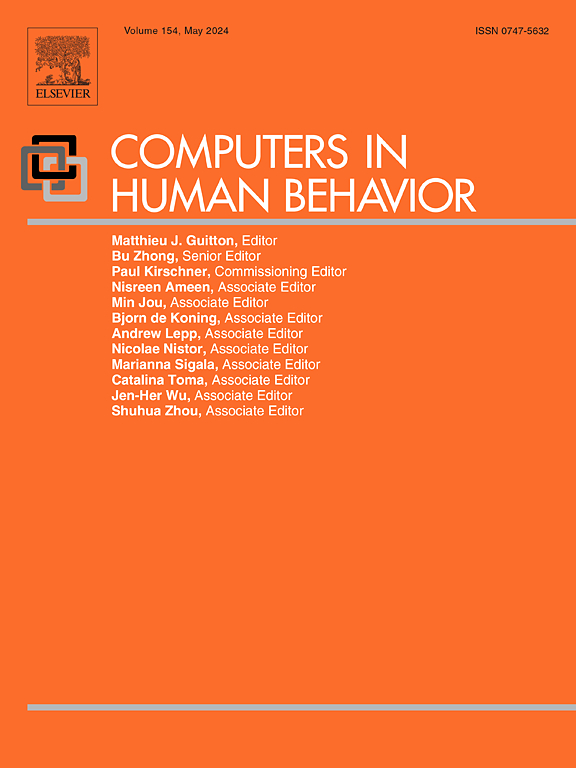美女vs.氛围:解构在线约会的视觉吸引力与大型多模态模型
IF 8.9
1区 心理学
Q1 PSYCHOLOGY, EXPERIMENTAL
引用次数: 0
摘要
网上约会已经成为一种社交基础设施,超过三分之一的婚姻来自数字平台。尽管它很重要,但我们对用户如何形成印象和做出匹配决策的理解仍然有限。本研究通过提出和测试印象形成的“双路径启发式模型”来解决这一差距,认为用户通过两条平行的途径来评估个人资料:对面部吸引力的直接、情感评估和对社会吸引力(或氛围)的更具推断性的评估。利用韩国一个主要异性恋约会平台上10619名用户的数据,我们利用大型多模态模型(Large Multimodal Model, LMM)来量化面部吸引力和社会吸引力,将后者分解为其关键组成部分:社会、经济和文化资本。通过计量经济学分析,我们考察了这两种途径对匹配成功的独立效应和相互作用。我们的研究结果表明,虽然面部吸引力和社交吸引力都是配对成功的有力预测因素,但面部吸引力对男性形象的影响尤其决定性。此外,我们的分析揭示了显著的负面交互效应,表明当用户的面部吸引力已经非常高时,增加强烈的社会或文化资本信号的收益递减。这些结果为数字环境中印象形成的非线性模式提供了新的见解,并为用户和平台设计师提供了实际意义,表明需要展示超越物理外观的身份多维方面的界面。本文章由计算机程序翻译,如有差异,请以英文原文为准。
Beauty vs. Vibe: Deconstructing visual appeal in online dating with large multimodal models
Online dating has become a social infrastructure, with over one-third of marriages originating from digital platforms. Despite its significance, our understanding of how users form impressions and make matching decisions remains limited. This study addresses this gap by proposing and testing a ”Two-Pathway Heuristic Model” of impression formation, arguing that users evaluate profiles via two parallel pathways: an immediate, affective assessment of facial attractiveness and a more inferential assessment of social attractiveness (or vibe). Using data from 10,619 users on a major heterosexual dating platform in South Korea, we leverage a Large Multimodal Model (LMM) to quantify facial attractiveness and social attractiveness, decomposing the latter into its key components: social, economic, and cultural capital. Through econometric analyses, we examine both the independent and the interaction effects of these two pathways on matching success. Our findings reveal that while both facial attractiveness and social attractiveness are strong predictors of matching success, the effect of facial attractiveness is particularly decisive for male profiles. Furthermore, our analysis uncovers significant negative interaction effects, suggesting that when a user’s facial attractiveness is already very high, adding strong signals of social or cultural capital yields diminishing returns. These results offer novel insights into the non-linear patterns of impression formation in digital environments and provide practical implications for both users and platform designers, suggesting a need for interfaces that showcase multi-dimensional aspects of identity beyond physical appearance.
求助全文
通过发布文献求助,成功后即可免费获取论文全文。
去求助
来源期刊

Computers in Human Behavior
Multiple-
CiteScore
19.10
自引率
4.00%
发文量
381
审稿时长
40 days
期刊介绍:
Computers in Human Behavior is a scholarly journal that explores the psychological aspects of computer use. It covers original theoretical works, research reports, literature reviews, and software and book reviews. The journal examines both the use of computers in psychology, psychiatry, and related fields, and the psychological impact of computer use on individuals, groups, and society. Articles discuss topics such as professional practice, training, research, human development, learning, cognition, personality, and social interactions. It focuses on human interactions with computers, considering the computer as a medium through which human behaviors are shaped and expressed. Professionals interested in the psychological aspects of computer use will find this journal valuable, even with limited knowledge of computers.
 求助内容:
求助内容: 应助结果提醒方式:
应助结果提醒方式:


